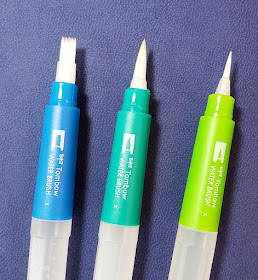 |
| Tombow waterbrushes |
One
of my sketch kit essentials is and always has been a waterbrush. If I were still
using watercolors to sketch with, I probably would have upgraded to a “real”
brush a long time ago. With watercolor pencils as my primary color medium,
however, I think plastic-bristle waterbrushes are actually more effective
(not to mention more convenient). Dispensing a small amount of water at a time
(the bane of painters when they need a juicy wash), a waterbrush is easy to
control when used with water-soluble pencils. Most artists hate ‘em (once in an
urban sketching workshop, the instructor forbade me from using mine!), but I
like ‘em.
For
years my favorite has been the Kuretake. I spotted a new one on JetPens
the other day – a set of three Tombow Water Brush Pens. Although Tombow makes a wide variety of popular colored brush pens, I didn’t recall seeing
a waterbrush with the Tombow name before, so I thought these would be worth a
try.
The set of three includes a flat wash, a medium round and a small round.
When
I unscrewed the reservoirs to fill them, I frowned when I saw that there’s no
plug between the reservoir and the connection to the bristles. (Compare that
with the Kuretake, which has a black plug.) When I’ve used other waterbrushes
without plugs, they have tended to gush a bit too freely, so I was afraid that
would be the case with the Tombows. The absent plug does make the Tombows easy
to fill: Just hold the open reservoir under the tap. (This is the same way I fill a Kuretake except the plug has to be removed.)
To
my surprise, the water doesn’t flow excessively from the Tombows; in fact, they
are just a bit wetter than the Kuretakes I’m used to. In my usual manner, I
gave the reservoir a gentle squeeze to wet the bristles and dabbed off any
excess water. I ran each brush tip once through a swatch of Caran d’Ache Museum Aquarelle colored pencil in a Stillman & Birn Beta sketchbook.
The water flow and control were similar to the Kuretake.
Next
I gave each brush a generous squeeze to thoroughly wet the bristles, dipped it
into a watercolor cake, and made a single stroke in the Beta sketchbook. Again,
I thought the flow was predictable and easy to control.
I
think the two rounds are the most functional and versatile sizes for use in
small and medium sketchbooks. Many waterbrush manufacturers seem to offer a
flat option, but I’m stumped as to when it’s useful. It’s not nearly wide
enough to make a traditional watercolor wash, even on small paper. (If anyone
has used a flat waterbrush effectively, I’m interested in hearing about it.)
The
Tombow waterbrush pens seem as good as the Kuretakes except in one important
regard: The caps do not post well. When I took them out for urban sketching, the
caps kept falling off as soon as I posted them, and I ended up having to put them
in a pocket to avoid losing them. On location, this is a deal breaker; I will undoubtedly
lose those caps immediately, and a capless waterbrush is a useless waterbrush.
At my desk, however, they are fine.





I found that water control was as important with watercolor pencils as with watercolors, though I'm not a big wet-on-wet kind of guy (not smart enough). I can't use waterbrushes because of the lack of water control. I'm amazed that others can. Again, I'm probably not smart enough :-)
ReplyDeleteAs for the flat brush thing, I have no experience with waterbrush flats, though my buddy uses one all the time. I have become interested in flat brushes. The reason is sort of the same reason Liz Steel likes her dagger brush. With a flat you can get big wide strokes, cuz its flat, or very fine lines by using the corner of the brush. It's sort of like the reason people like fude nibs :-)
I've often thought that a dagger brush must be similar to a fude nib! I suppose it becomes a drawing tool as well as a painting tool.
Delete